Agricultural Literacy Curriculum Matrix
Lesson Plan
From Techniques to Traits
Grade Level
Purpose
This lesson explores common biotechnology methods and their applications in agricultural sciences. Students will examine DNA analysis techniques, become familiar with the process of polymerase chain reaction (PCR), and evaluate methods of DNA analysis as they learn how the biological techniques can be used in the process of developing specific traits within a crop. Grades 9-12
Estimated Time
Materials Needed
Engage:
- Environmental Scenario Cards (cut and packaged in a plastic bag; 1 per group)
- From Gene to Trait image (projected for whole class)
Activity 1: DNA Analysis Techniques
- DNA Analysis Techniques Graphic Organizer (1 per student, printed single-sided)
- Scissors and staples, glue, or tape
Activity 2: PCR
- PCR Sequencing Cards (cut, shuffled and packaged in a plastic bag: 1 per group)
Activity 3: Case Study Application and Evaluation
- Environmental Scenario Cards (from Interest Approach)
- Environmental Stressor Case Study (1 copy per group or student; or projected digitally for entire class)
- Poster or chart paper (1 per group)
- Markers
- Sticky notes
Vocabulary
biotechnology: the use of living systems and organisms to develop or modify products or processes
gel electrophoresis: a method for separation and analysis of macromolecules (DNA, RNA and proteins) and their fragments, based on their size and charge
gene: a unit of heredity that is transferred from a parent to offspring and is held to determine some characteristic of the offspring
genetically modified organism (GMO): any organism whose genetic material has been altered using genetic engineering techniques
genotype: the genetic makeup of an organism
phenotype: the set of observable characteristics of an organism resulting from the interaction of its genotype with the environment
polymerase chain reaction (PCR): a technique to make many copies of a specific DNA region in vitro (in a test tube rather than an organism)
recombinant DNA: joining together of DNA molecules from two different species that are inserted into a host organism to produce new genetic combinations
restriction enzyme: DNA-cutting enzymes that recognize one or a few target sequences and cuts DNA at or near those sequences
selective breeding: process by which humans control the breeding of plants or animals in order to exhibit or eliminate a particular characteristic
trait: observable, physical characteristic obtained through genetic inheritance
Did You Know?
- Selective breeding has been occurring for thousands of years. Modern corn development began almost 10,000 years ago by selectively breeding a grass known as teosinte.1
- Over 80% of soybeans and corn produced in the United States are genetically modified for insect resistance or herbicide tolerance.2
- In 1909, Nils Heribert-Nilsson first demonstrated how crossing plants and creating hybrids results in plants that are better than the parents. This is known as hybrid vigor.3
Background Agricultural Connections
Humans have long been modifying crops to make them more useful. Today, corn is the largest cash crop produced by the United States. It has an enormously wide variety of uses, including human food, animal feed, food preservation, adhesives, pharmaceutical production, and fuel production.4 But corn has not always looked like the corn we are familiar with, with large ears of neat, yellow kernels. Thousands of years ago, corn was growing as a much smaller grass known as teosinte. Thanks to selective breeding, modern corn has much larger, more numerous, and more nutritious kernels than its parent grass.5
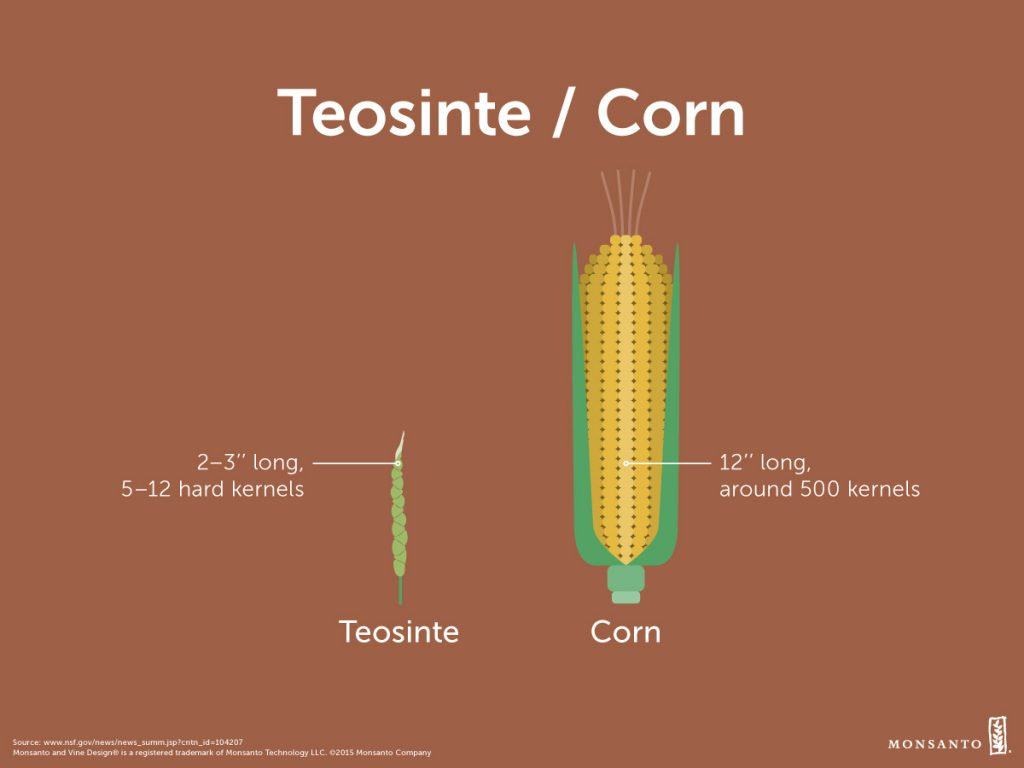 Image Source: https://monsanto.pr/vegetables-in-action-corn/
Image Source: https://monsanto.pr/vegetables-in-action-corn/
Since prehistory, humans have used selective breeding to improve crops by breeding together plants with desirable characteristics over many generations. However, until about 1900, genes and their relationship to traits were virtually unknown. Selective breeding was done based only on observable phenotypes, or characteristics. Today, scientists and plant breeders combine their knowledge of plant characteristics with information on plant genotypes, or genetics, to breed the best possible crops. By carefully choosing which plants to breed, they can develop crops that are more drought tolerant, insect resistant, herbicide tolerant, and more.
Scientists can even go a step further and insert desirable genes from other species into a plant’s genome (the plant’s DNA), conferring beneficial traits that would otherwise not occur. These new plants are a type of genetically modified organism. In 2012, 93% of soybeans and 88% of corn planted in the United States was genetically modified.6 The ability to genetically modify plants allows scientists to more quickly develop hardier, more nutritious crops that have an increased yield. Golden rice is a genetically modified rice crop that produces more beta-carotene (a vitamin A precursor) than white rice. The genes for this amplified beta-carotene production came from daffodils and bacteria. Roundup Ready® soybeans have a gene in their genome from a bacteria, making them resistant to the herbicide glyphosate. This allows them to be sprayed with the herbicide, killing the weeds around them and minimizing competition while leaving the soybeans unaffected.7 Bt corn contains a gene derived from bacteria that produces an enzyme deadly to an insect known as the European Corn Borer. This protects the corn from the insect, reduces the need to spray pesticides, and increases crop yield.8
In order for scientists and plant breeders to selectively breed the best possible crops, or develop a genetically modified crop, they rely on the ability to analyze the DNA of plants. A wide variety of biotechnology techniques can be used to help them do that.
Normally, the DNA of a plant is found in the nucleus of its cells. To analyze the DNA and identify genes that are beneficial to the crop, scientists must be able to get the DNA out of a plant’s cells. A technique known as DNA extraction is used to do this. DNA extraction uses various chemicals, including detergents and alcohol, to open a cell and separate the DNA from the rest of the cellular components.
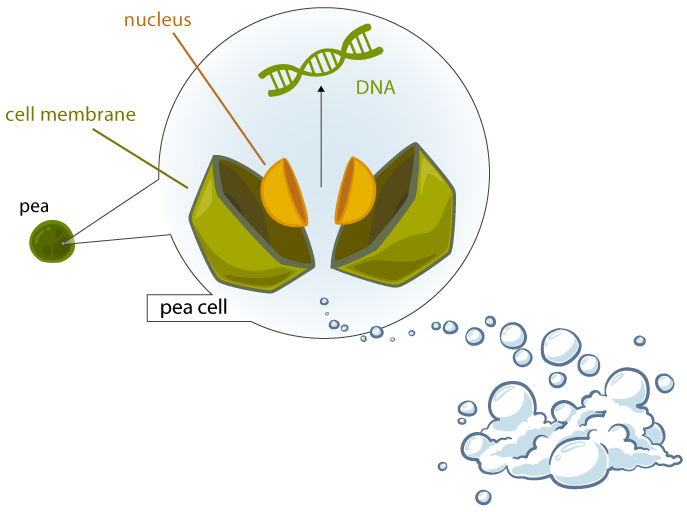 Image Source: https://learn.genetics.utah.edu/content/labs/extraction/howto/
Image Source: https://learn.genetics.utah.edu/content/labs/extraction/howto/
However, the amount of DNA extracted from the plant cells is often too small to work with easily. Scientists can make the DNA sample much larger by using a technique known as polymerase chain reaction (PCR). This technique mimics natural DNA replication in the cell, and makes many, many copies of the DNA.
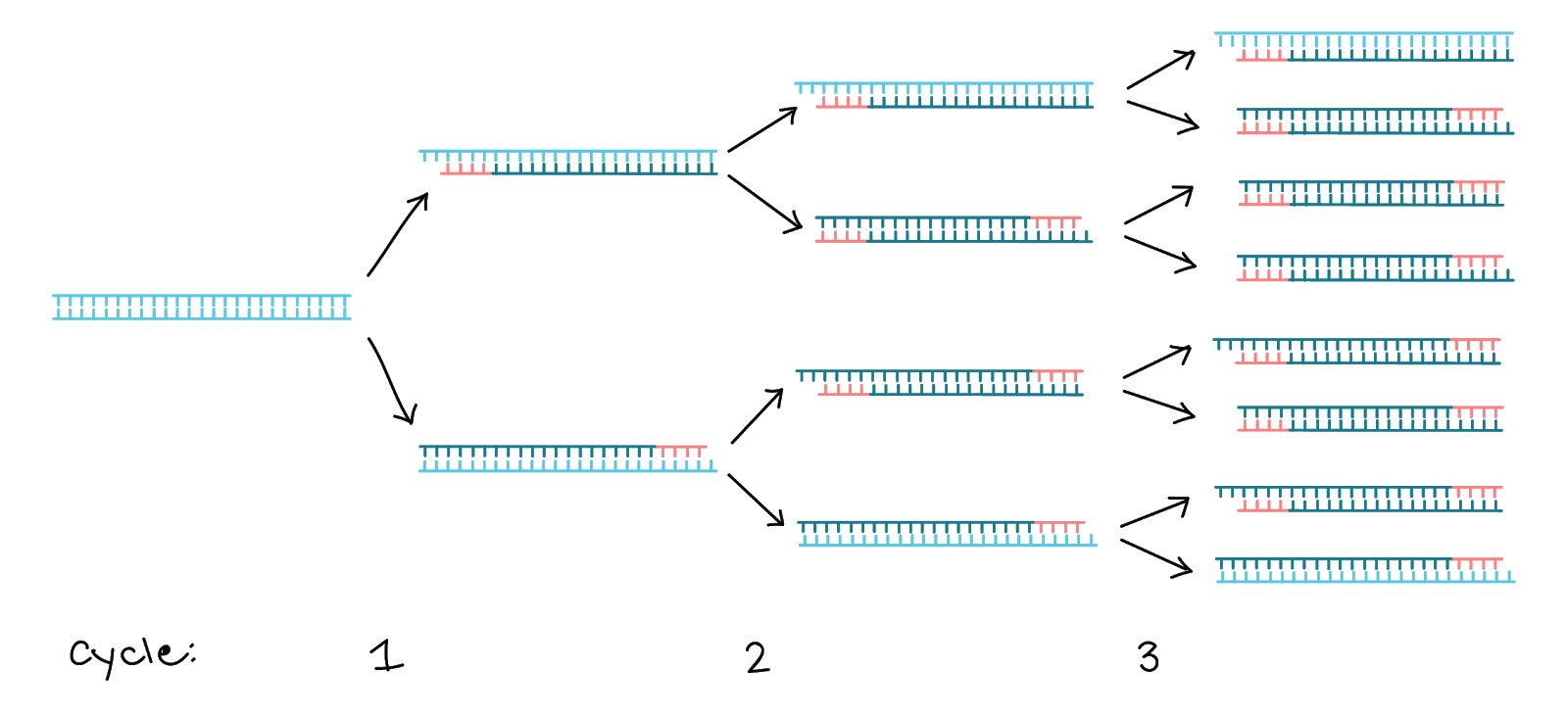
Image Source: https://www.khanacademy.org/science/biology/biotech-dna-technology/dna-sequencing-pcr-electrophoresis/a/polymerase-chain-reaction-pcr
Typically, scientists don’t want or need the entire genome of the plant - they often only want to identify or work with a small portion. Restriction enzymes can be used to cut the DNA into pieces, making it much easier to find the portion of interest. Restriction enzymes are naturally found in bacteria. Bacteria use restriction enzymes to cut up foreign DNA, such as that from an invading virus. Restriction enzymes are used in a very broad range of scientific research, including medical and agricultural research.
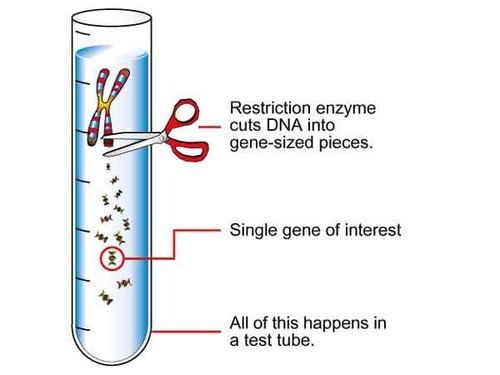
Image Source: https://www.indiamart.com/proddetail/restriction-enzymes-9533118348.html
To quickly observe characteristics of a plant’s DNA and identify sequences that a scientist may be looking for, a technique known as gel electrophoresis can be used. Gel electrophoresis allows a scientist to separate molecules based on size. In this case, the plant DNA fragments that were formed when the DNA was cut with restriction enzymes can be separated from largest to smallest. This can be used to identify whether a particular gene or sequence is present in the plant’s genome.
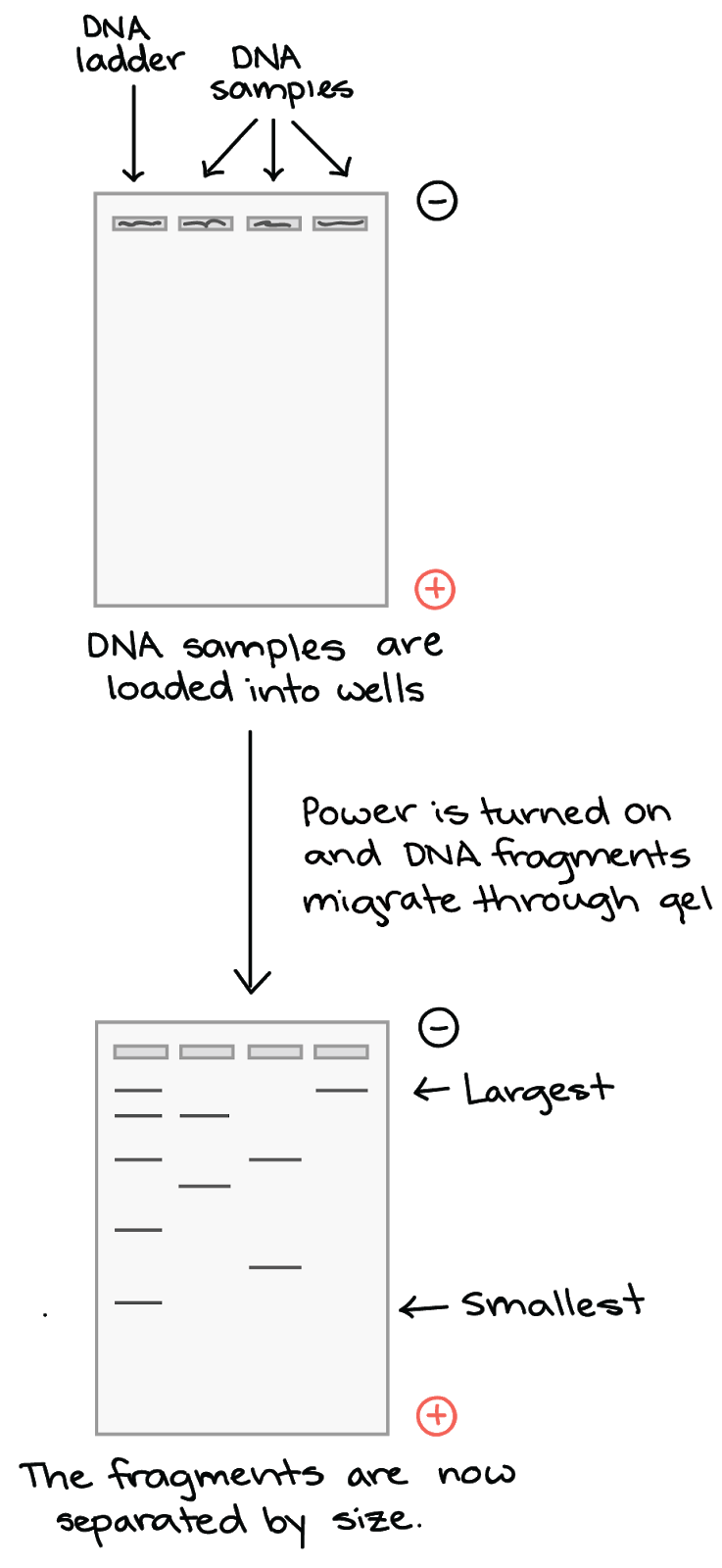
Image Source: https://www.khanacademy.org/science/biology/biotech-dna-technology/dna-sequencing-pcr-electrophoresis/a/gel-electrophoresis
All of these techniques may be used when identifying natural, beneficial genes, or when creating genetically modified crops using recombinant DNA. Recombinant DNA is formed when the DNA of more than one species are put together. This is the basis of the creation of genetically modified crops. A gene from one organism (for example, the gene from the bacterium Bacillus thuringiensis that produces a protein that is toxic to the European corn borer) can be combined with another (for example, the DNA of a corn plant), and a new plant can be grown with the Bt gene.
 Image Source: https://schoolworkhelper.net/bt-corn-genetically-modified-corn/bt-corn-genetically-modified-corn/
Image Source: https://schoolworkhelper.net/bt-corn-genetically-modified-corn/bt-corn-genetically-modified-corn/
It is important to realize that each of these DNA analysis techniques is one tool a scientist can use in a long process of gene identification and manipulation. Each has a wide variety of applications, in agriscience as well as other areas. In this lesson, students will gain a general understanding of each technique and their role in DNA analysis, as well as how general DNA manipulation can be used to develop improved crops.
Engage
- Divide students into small groups and distribute one set of Environmental Scenarios Cards to each group. Inform students that half of their cards describe a scenario for growing crops and the other half list a trait that could be found in a crop. Instruct students to read the scenarios and match them with a desired trait for each situation. Encourage students to justify their reasoning for each match.
- Draw on students' prior knowledge by asking them to explain the relationship between a gene and a trait. Have students explain why a certain trait may be more beneficial in a particular environment than another.
- Next, ask students to brainstorm additional environmental stressors that plants may need to overcome. Examples include humidity, pollution, elevation, salinity, pH, and predators.
- Teacher Tip: Consider using digital resources such as Padlet, Socrative, or Mentimeter to increase student engagement and to record student responses.
- Summarize by displaying the From Gene to Trait image. Confirm that students understand that a gene is a segment of DNA that codes for a protein or some functional product (i.e. tRNA, rRNA, etc.). They should also understand there are other regions of DNA that do not code directly for proteins, but may play a regulatory role in gene expression. For example, a farmer can look at a plant that is expressing a desirable trait and breed that plant to further amplify the expression of beneficial genes without necessarily knowing the exact DNA sequence of those genes. Additionally, biotechnology can aid scientists in the identification of gene sequences that lead to beneficial traits, which can help them develop improved crop varieties. This can speed the process of developing better adapted crops, thus increasing yield and reducing food shortage.
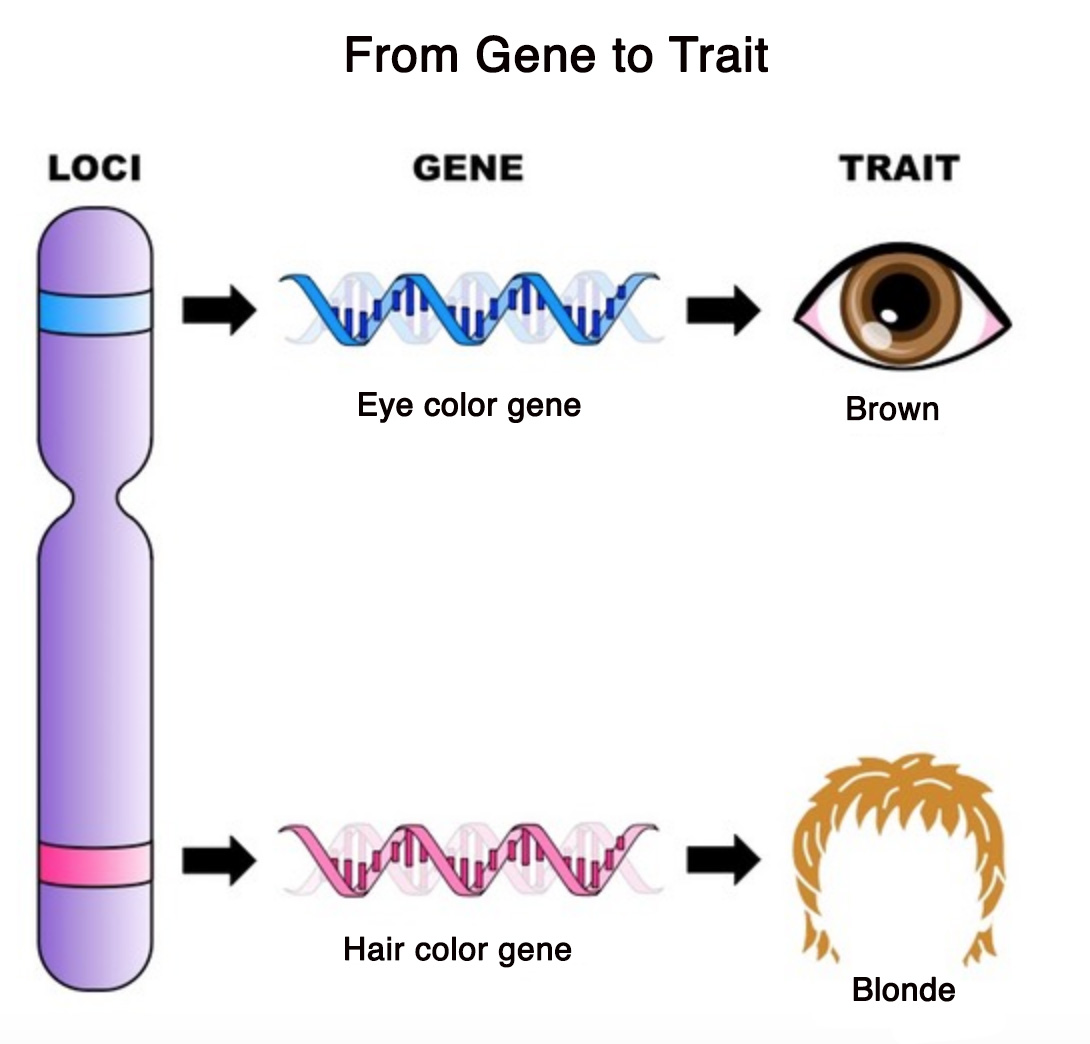 Image Source: http://ib.bioninja.com.au/standard-level/topic-3-genetics/31-genes/genes-and-loci.html
Image Source: http://ib.bioninja.com.au/standard-level/topic-3-genetics/31-genes/genes-and-loci.html
Explore and Explain
Activity 1: DNA Analysis Techniques
- Ask students, "Where is DNA found within a cell?" Students should recall from prior knowledge that DNA is found in the nucleus of eukaryotic cells. Remind them that DNA contains genes that code for proteins, which lead to traits.
- Next ask, "If DNA is found within the cell, how can it be viewed or analyzed?" Explain that there are several methods used by scientists to extract, view, and analyze DNA. Today we will be learning four of them.
- Give each student group one copy of the DNA Analysis Techniques Graphic Organizer. Instruct students to set aside page one and cut out the cards on page two.
- Next, have students match the DNA analysis technique to its description and illustration. The three cards can be connected with a staple, glue, or tape.
- Note: Students are not necessarily expected to know these scientific processes yet. The activity is designed to be an assessment of prior knowledge.
- Come back together as a class and share out examples until all of the DNA analysis techniques have been correctly matched and described.
- Have students read the scenario and follow the instructions on page one of their DNA Analysis Graphic Organizer. Students will complete the graphic organizer by placing the DNA analysis technique in the correct portion of the graphic organizer. The goal of this activity is to correctly assess if students understand which DNA analysis technique is appropriate for a given task.
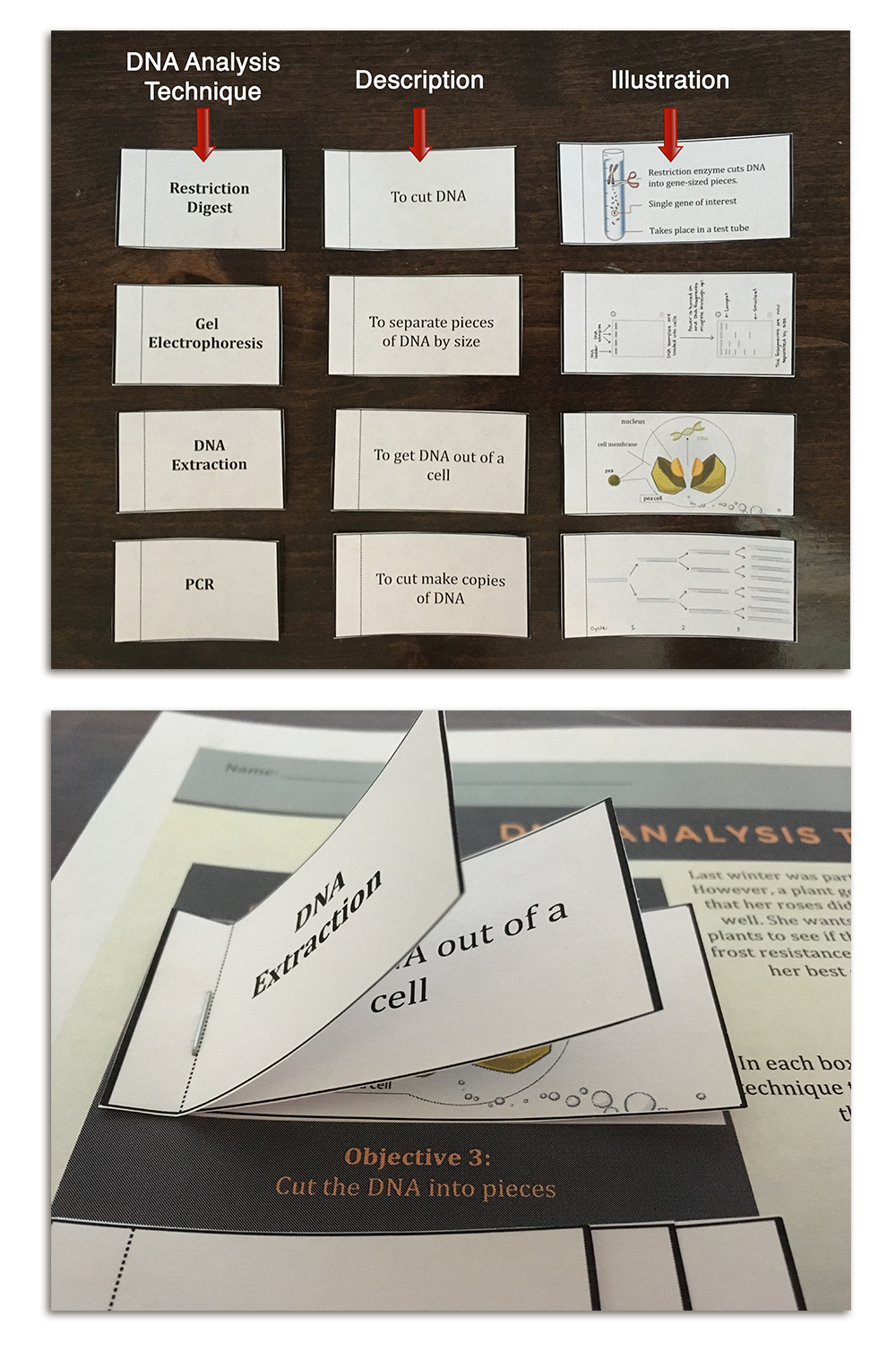
Alternative Approach: This activity can also be adapted to be completed in groups. Print one copy of the graphic organizer per group and challenge students to research each analysis method to complete the activity together.
Activity 2: PCR
- Explain to students that they will be learning more about PCR (polymerase chain reaction), one of the four techniques they were introduced to in Activity 1. Ensure that they understand that the overall purpose of PCR is to amplify (make more copies of) DNA. PCR is a commonly used tool in forensic science, medical and biological research, and agriscience. Being able to have a large amount of DNA to work with is crucial, as opposed to a tiny sample that may be prone to contamination or human error.
- Direct students to read a basic introduction to PCR.
- When students are done reading, place students into groups of 2-3. Give each group a set of PCR Sequencing Cards. Instruct students to organize the cards to illustrate the correct order of the three main steps of PCR. Each step should include a name, description, and a picture as illustrated below.
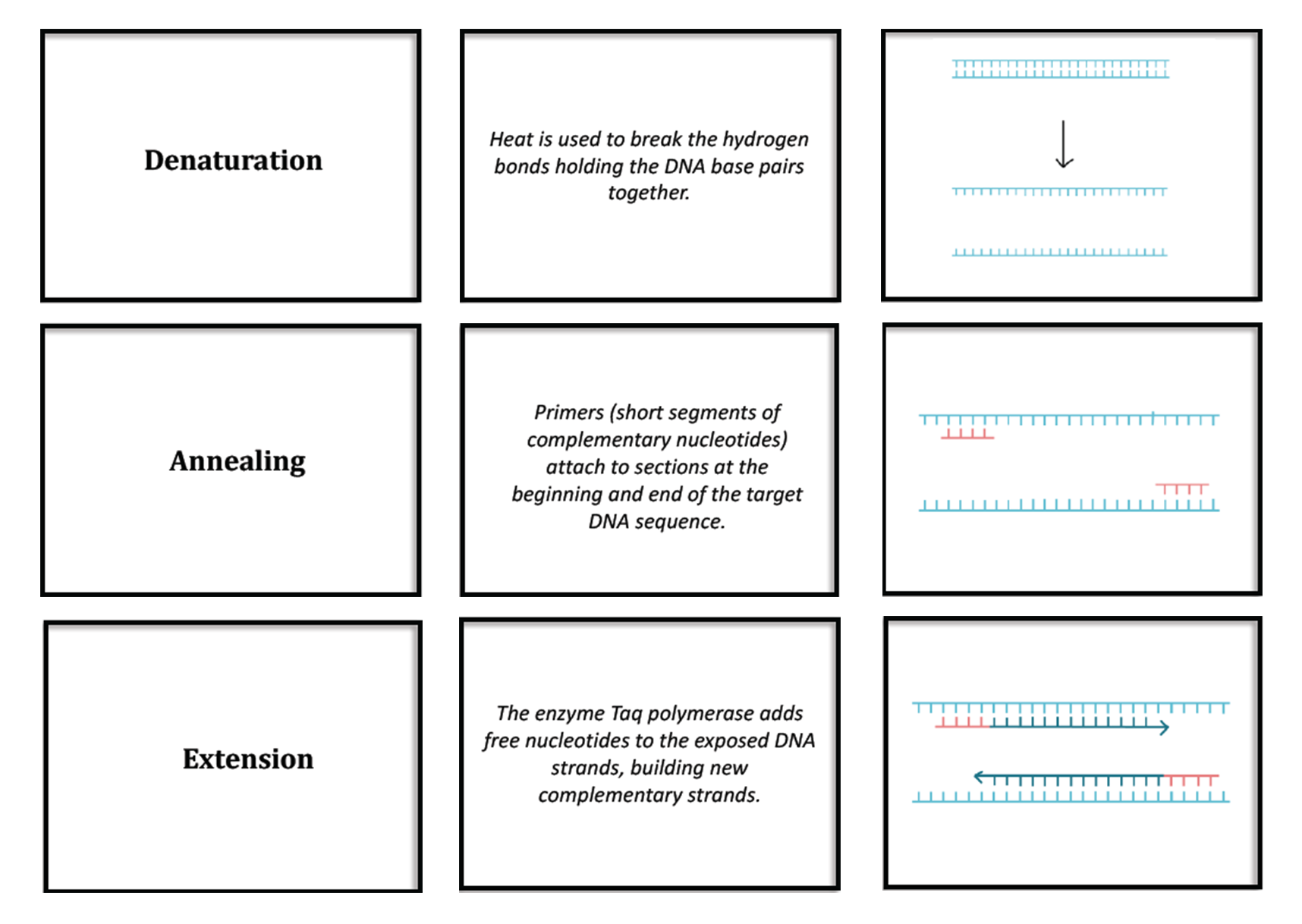
- Project the cycling image from the Khan Academy site that students saw in step 2. Explain that PCR allows exponential amplification of DNA, and can produce millions of copies of a target sequence in a matter of hours.
- Complete this activity with a reminder of the necessity of doing PCR before most testing and experiments using DNA.
- As an additional extension, students can demonstrate this process on the tabletop using materials such as flash cards, play dough, or markers, and/or create a short video of this process using apps such as Stop Motion Studio (claymation).
Activity 3: Case Study Application and Evaluation
- Return a set of Environmental Scenario Cards to each student group (previously used in the Interest Approach). Also give each group a copy of the Environmental Stressor Case Study, a piece of chart paper, and a marker.
- Note: Rather than distributing hard copies of the case study, you may also choose to project the case study to the whole class.
- Instruct students to consult their DNA Analysis Techniques graphic organizer from Activity 1 and recall previous activities to place the DNA analysis techniques in the appropriate order that they should use to solve the problem in the case study.
- In their groups, students should create a Plan of Action poster to share with the class. Their poster should include three headings:
- DNA Techniques: List the DNA analysis techniques that should be used as well as the order they believe the technologies should be used (and if they should all be used).
- Steps the Researcher Should Take: Include information directly from the student flowchart describing what steps should be taken.
- Anticipated Outcome: Explain the outcome the researcher would hope for.
- After student groups complete their posters, provide sticky notes to students and instruct them to walk around the room and evaluate each other's posters and leave feedback on the posters (i.e. Do you agree with their process? If so, why? Alternatively, if you disagree, why?) They may also leave behind questions and any additional comments they may have. It is important to remind students that they are evaluating someone else's work, so they should be mindful of their feedback and respectful.
- Allow students time to view the feedback left on their poster, and make corrections if necessary.
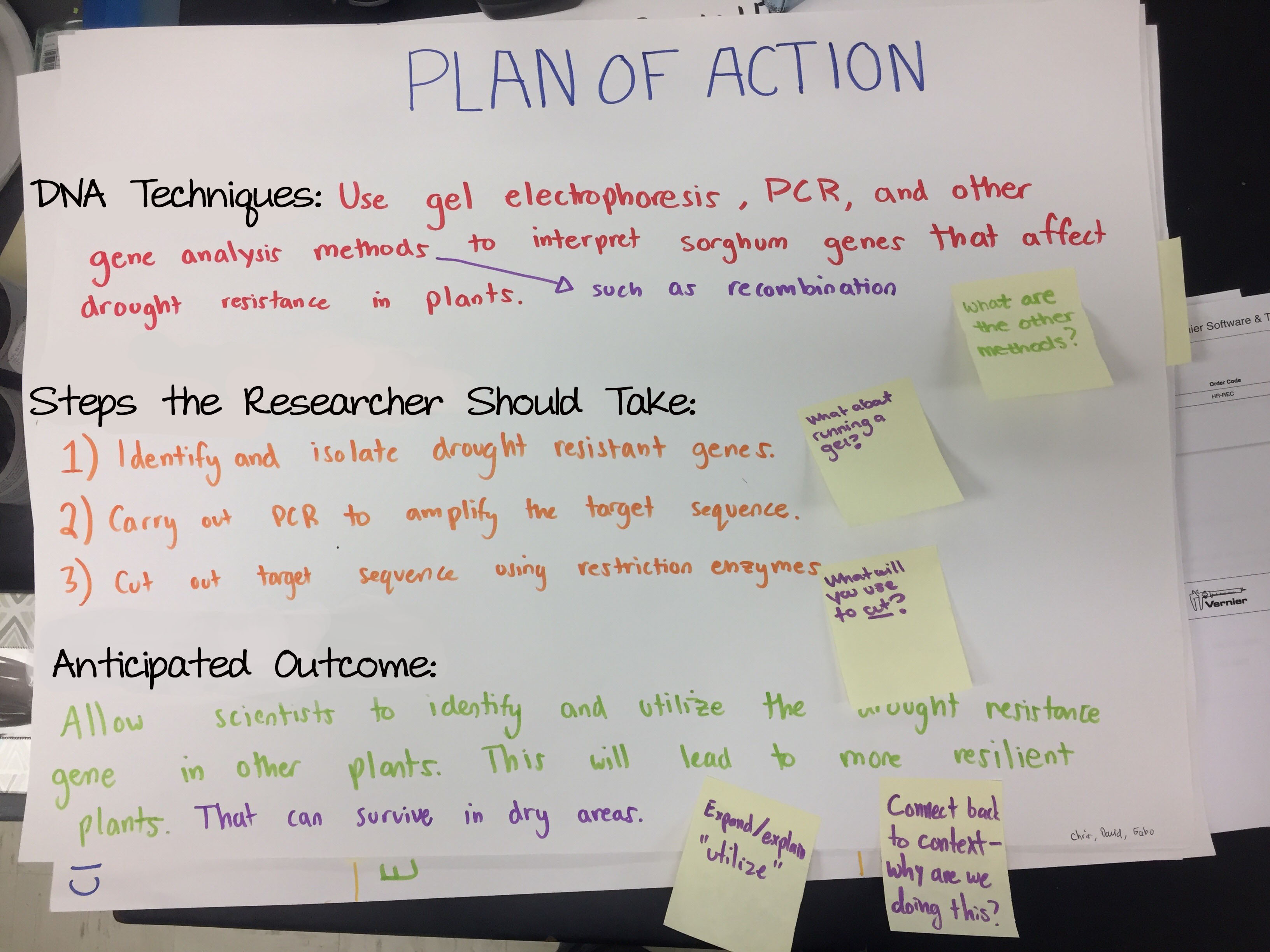
Evaluate
After conducting these activities, review and summarize the following key concepts:
- Science and biology are used to improve the production of our food and overcome specific challenges in agriculture.
- PCR (Polymerase Chain Reaction) is used to make many copies of specific DNA regions.
- DNA analysis techniques are tools scientists can use in the process of gene identification and manipulation.
Sources
- https://learn.genetics.utah.edu/content/selection/corn/
- https://ohioline.osu.edu/factsheet/HYG-5058
- https://monsanto.com/app/uploads/2017/06/history-of-plant-breeding.pdf
- https://www2.education.uiowa.edu/html/eportfolio/tep/07es102folder/miniweb/usesofcorn.htm
- https://learn.genetics.utah.edu/content/selection/corn/
- https://www.fda.gov/food/ingredientspackaginglabeling/geplants/ucm461805.htm
- https://en.wikipedia.org/wiki/Genetically_modified_soybean
- https://entomology.ca.uky.edu/ef130
Recommended Companion Resources
Author
Organization
| We welcome your feedback! If you have a question about this lesson or would like to report a broken link, please send us an email at matrixelearning@gmail.com. If you have used this lesson and are willing to share your experience, we will provide you with a coupon code for 10% off your next purchase at AgClassroomStore. |
